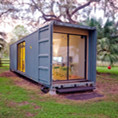Shipping containers are designed to withstand extreme weather conditions, so your container in Ontario will remain standing year-round, keeping the elements and vermin out. However, this doesn’t necessarily mean that the inside environment will be comfortable unless you make certain preparations to ensure that it is warm in winter and cool in summer.
Your shipping container home needs to be insulated to make it livable. The interior gets extremely hot during summer and extremely cold during winter because heat moves easily through the steel structure. Insulation is used to maintain the inside temperatures without much influence from the elements. Depending on your region’s climate, you may need both insulation and weather-proofing to maintain stable indoor temperatures for optimal comfort.
Generally, wet climates are more dangerous than dry ones to a steel home because the moisture can cause the metal to rust. So, it’s vital to keep moisture and condensation away from your home’s structure. This is particularly important when insulating your container home externally. Though container walls have a shallow depth and limited space, you can still install interior insulation. With both options, you need to build out the walls to provide sufficient depth for insulation.
Some common types of insulation for shipping container homes include:
Spray foam. This provides a quick and easy way to insulate your home by spraying the insulation material directly on your unit’s exterior and interior walls.
Wool. This is a natural insulation obtained from sheep wool. It is environmentally friendly and offers high-performance insulation with an R-value of 3.5 per inch. In addition, sheep wool contains a natural flame retardant (lanolin), eliminating the need to treat the insulation with chemicals.
Cotton-based insulation. This natural insulation material is made from recycled, post-consumer cotton and denim attire. It has an R-value of 3.5 per inch, which is the same protection you get with fibreglass insulation. Moreover, cotton insulation also contains boric acid, which is a fire retardant. However, this insulation needs to be installed with a vapour barrier to prevent it from getting wet and losing its insulation properties.
Cork. This is a natural insulator. Cork is biodegradable and is obtained from cork trees by harvesting their bark rather than cutting them down. It is not only an environmentally friendly insulation material but also a great option for people looking for the added benefit of sound insulation for interior or exterior metal walls.






















共有条评论 网友评论